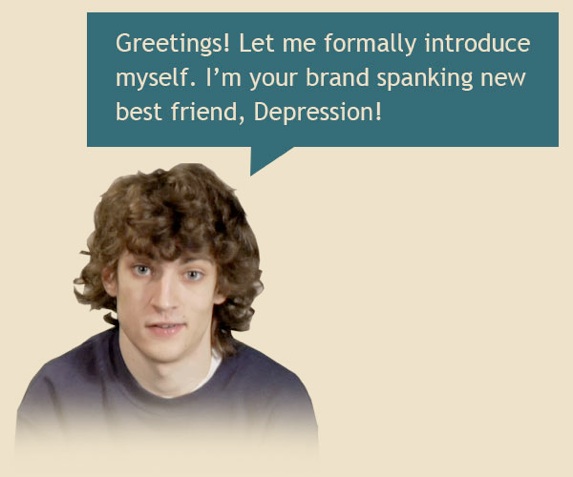Latest Public Service Radio Minute
Loss of EmploymentLoss of Employment, MP3, 1.3MB
Listen to or download all our PSAsSupport Our Work
Please donate so we can continue our work to reduce the stigma of psychiatric illness, encourage research, and support educational activities for behavioral health professionals and the public. Ways you can donate and help are on our Support and Donations page. Thank you!
More InfoLatest News Around the Web
State, Federal Lawmakers Taking Action Against Powdered Alcohol
On the front of its Business Day section, the New York Times (4/4, B1, Abrams, Subscription Publication) reported on the state and Federal lawmakers who seek to ban powdered alcohol, Palcohol, “before it even comes to market,” amid concerns that the substance could be easily abused. So far, “six states have passed legislation to ban powdered alcohol outright,” and Sen. Chuck Schumer (D-NY) “introduced a bill last month that would ban its sale and manufacture nationwide.” While in the past the FDA “has weighed in on some alcoholic products, like the beverage Four Loko,” the agency has not “become involved with Palcohol,” and “said that the ingredients in Palcohol were typical of those found in many processed foods and that they complied with” regulations.
Related Links:
— “Powdered Alcohol Meets Resistance in U.S. Before It Even Comes to Market,” RACHEL ABRAMS, New York Times, April 3, 2015.
NIMH Director Calls Attention To Suicide As Major Public Health Problem
Politico (4/4, Villakorta) reported that with the Germanwings plane crash encouraging discussion about suicide, “National Institute of Mental Health Director Thomas Insel is urging people not to forget about this public health problem once it fades from the headlines.” Dr. Insel stated, “Unlike many of the leading causes of death, the suicide rate has shown no appreciable decline over the last 50 years; indeed, the rate among middle-aged Americans is increasing, and for young people ages 15-34, it is not the tenth, but the second leading cause of death.” He added, “When will we change our national habit of paying brief attention to suicide when circumstances make it newsworthy and start viewing it as the major public health problem it is: one to be addressed by marshaling — and sustaining — research, as we have for other health issues, with the clear goal of saving lives.
Related Links:
— “The downsides to the SGR fix — Obamacare’s next fight: the Cadillac tax — Gruber too high with repeal estimate,” NATALIE VILLACORTA, Politico, April 3, 2015.
Experts Theorize Aggression, Not Just Depression, May Be Behind Germanwings Crash
The Los Angeles Times (4/6, Healy) reported in a 1,700-word story that “mental health experts say that it was aggression — not just depression — that would have driven 27-year-old Andreas Lubitz to deliberately crash a Germanwings airliner into a mountainside.” But, “unless investigators recognize the toxic role of aggression and hostility in some patients’ depression, they say, such troubled individuals will continue to elude detection — to the public’s peril.” The piece quoted aggression researcher and neuropsychiatrist Jeff Victoroff, MD, of the University of South California’s Keck School of Medicine, who said of Lubitz. “This was a murderous guy who probably had elements of a mood disorder and personality disorders.” Forensic psychiatrist Steven E. Pitt, DO, said, “There has to be a maladaptive character defect, a character disorder here.”
In an essay for Scientific American (4/6) titled “What Should Lufthansa Have Done to Prevent the Germanwings Tragedy?,” psychiatrist Jeffrey Lieberman, MD, immediate past president of the American Psychiatric Association, wrote that “the critical question is not whether someone has had an illness but whether it has been adequately treated and they are actively symptomatic or not.” Dr. Lieberman pointed out, “With some exceptions (commercial pilot licenses are not available to people with type 1 diabetes or epilepsy), we do not prohibit people from jobs just because they have an illness, unless its symptoms impair their ability to function adequately.” Dr. Lieberman concluded, “In general, someone who has a prior history of depression but has been effectively treated and is no longer symptomatic should not be prohibited from working,” and “forcing people to go underground with their mental illness will not make us safer in the air – or anywhere else.”
Related Links:
— “Aggression, not just depression, led copilot to crash plane, experts say,” Melissa Healy, Los Angeles Times, April 5, 2015.
NCAA To Study Effects Of Concussions On Student-Athletes
The Wall Street Journal (4/18, McGinty, Subscription Publication) reported that the NCAA, in partnership with the Defense Department, is funding a three-year, $30 million project to study the effects of concussions on about 37,000 student-athletes. The Journal reported that the concussion study seeks to record concussion effects from the initial hit through complete rehabilitation.
Related Links:
— “Short on Concussion Data, NCAA Sets Out to Get Some,” Jo Craven McGinty, Wall Street Journal, April 17, 2015.
Boys Who Have Been Victims Of Sexual Assault More Likely To Attempt Suicide.
HealthDay (4/18, Preidt) reported that adolescent “boys who have been a victim of sexual assault are likelier to attempt suicide,” according to a study published online in the journal Suicide and Life-Threatening Behavior. After analyzing “data from more than 31,000 American teens, aged 14 to 18, who took part in surveys in 2009 and 2011,” researchers found that among teen “boys, 3.5 percent of those with no history of sexual assault attempted suicide within the past year, compared with more than 33 percent of those who had been sexually assaulted.”
Related Links:
— “1 in 3 Teen Boys Sexually Assaulted Tries Suicide, Study Finds,” Robert Preidt, HealthDay, April 17, 2015.
Foundation News
Nothing Found
It seems we can’t find what you’re looking for. Perhaps searching can help.

